Noticed that patches of your lawn have died over winter? In this guide, we’ve discussed the most likely reasons why grass dues in the winter, and how to prevent these issues. We’ve also discussed what to do about dead grass after winter.
✅Key Takeaways:
The 6 reasons your grass might die in the winter are:
Exposure to below-freezing temperatures
Snow mould
Waterlogging
Sudden freezing
Lack of sunlight
Compacted soil
You can fix grass that has died in winter by raking or digging out the brown grass and overseeding the bare areas in early spring.
Table of Contents
🤷♂️ Why Does Grass Die In Winter? Quick Answer
Your grass might die in winter due to a combination of factors: freezing temperatures, waterlogging, snow mould, a lack of sunlight, and compacted soil. These factors stress the grass and create unfavourable growing conditions, causing it to turn brown and die (often referred to as “winter kill”).
📑 6 Reasons Why Your Grass Might Die In Winter
Here are the 6 most common reasons for dead grass on part of your lawn or your entire lawn surface over the winter months. Often, it’s a combination of these factors that cause patches of grass to die out.
❄️ Exposure To Below-Freezing Temperatures
Icy temperatures, dry winds, and frost are all part of the parcel of winter here in the UK. We have cool, not warm, season grasses, so our lawns are designed to withstand cold temperatures somewhat.
With that said, grass in the UK may still die in the winter as a result of exposure to below-freezing temperatures.
Snow cover actually protects grass, and we don’t usually get more than a few days of snow in Britain. Without the insulation of snow, grass is susceptible to “winter kill” because its frozen roots are unable to replace the moisture lost in very cold winter conditions, causing the plants’ cells to die.
How To Prevent
We might not be able to prevent the freezing temperatures that are synonymous with a UK winter – but we can at least implement lawn care practices to reduce the risk of cold weather damage.
Our top advice is to fertilise your lawn in autumn with an autumn/winter fertiliser. This will provide essential nutrients that support root development, helping turf grass establish a strong and deep root system. Strong roots are crucial for improved water and nutrient uptake, and reduce the risk of your grass dying completely if the leaves are exposed to frosty weather.
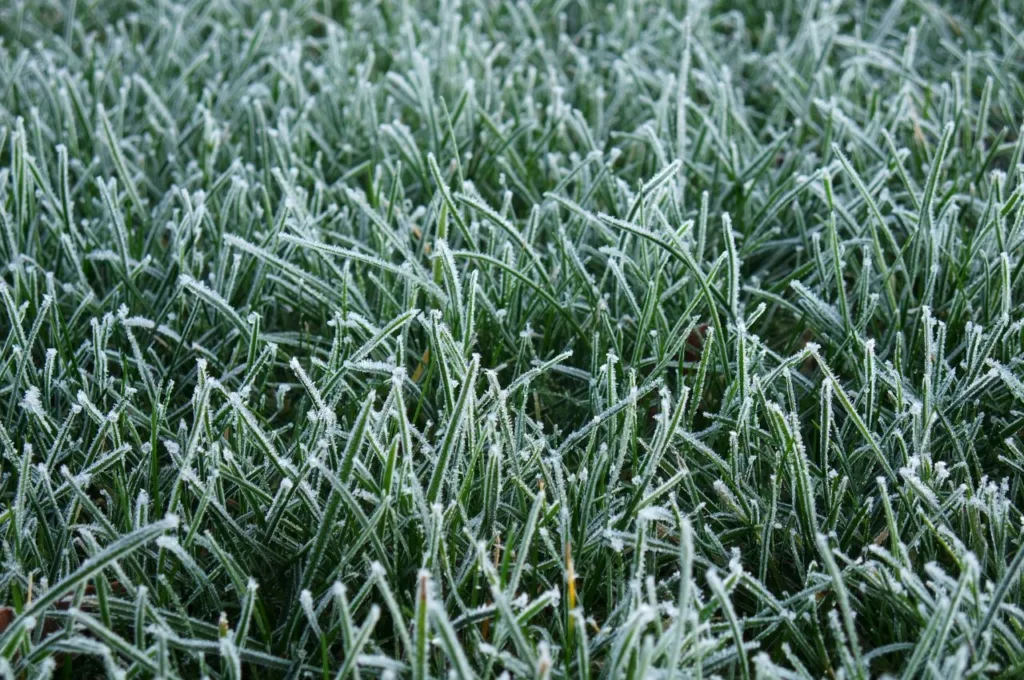
🦠 Snow Mould
Your lawn might also die in winter as a result of snow mould. This occurs due to heavy snowfall on ground that isn’t frozen over, giving rise to moisture, which promotes a number of fungal diseases (aka. snow mould).
If your grass has suffered the effects of snow mould, you’ll see pink or gray crusty or fuzzy spots on sections of your lawn. Thankfully, many winter fungal diseases die when the weather warms and the grass dries out in spring, but some may remain, causing sections of your grass to die.
How To Prevent
You can’t completely prevent snow mould, but you can at least reduce the likelihood of fungal diseases by aerating your lawn and raking it to remove thatch.
Aerating your lawn reduces drainage issues and creates space for air circulation, minimizing the accumulation of moisture that leads to snow mould. We’ve personally had a great experience with the Walensee Lawn Coring Aerator (< link to Amazon), but if you’re looking for more recommendations, we’ve reviewed some of the best electric and manual aerators for UK lawns here.
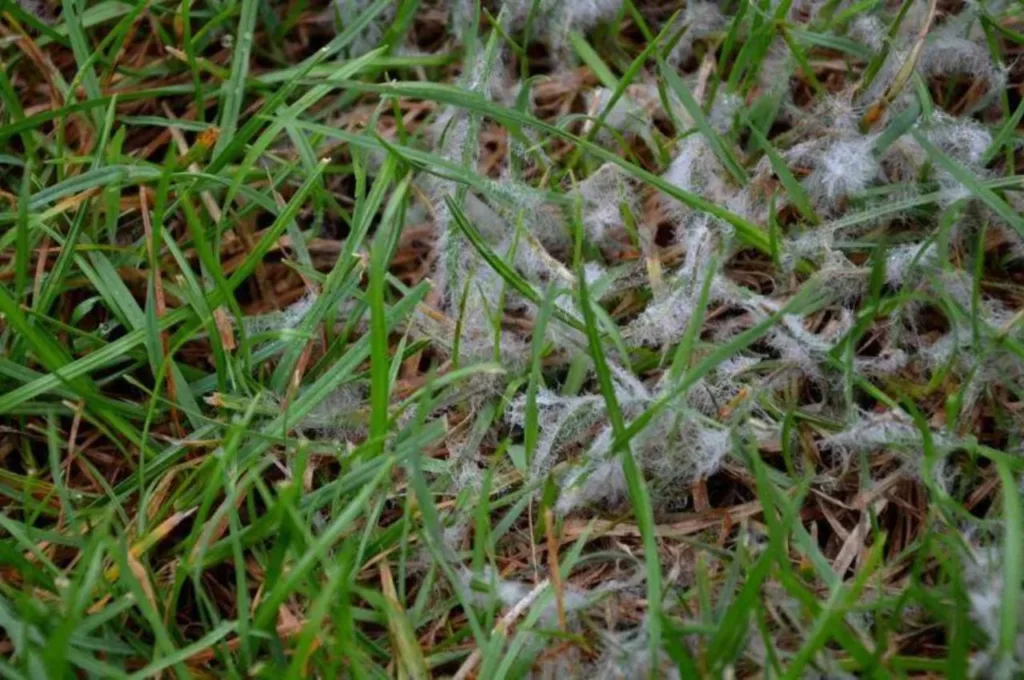
☔️ Waterlogging
Grass is more prone to waterlogging in the winter because of a combination of factors that are more likely in the cooler season: increased rainfall and damp conditions, compacted soil, reduced evaporation, slow growth and transpiration, and poor drainage.
Waterlogging can lead to dead grass on your lawn because the roots become deprived of essential oxygen. When soil becomes saturated with water, the air spaces in the soil are filled, leading to reduced oxygen availability to the grass roots. The outcome? root decay, reduced growth, and dead grass.
How To Prevent
Again, you can prevent waterlogging of your lawn in the winter and keep grass healthy by aerating your lawn in autumn. Aerating your lawn reduces the risk of waterlogging by creating channels in the soil that allow water to penetrate more easily and promote drainage.
If your lawn has ongoing drainage issues, you might need to consider installing a drainage system that will carry water away from the lawn surface.
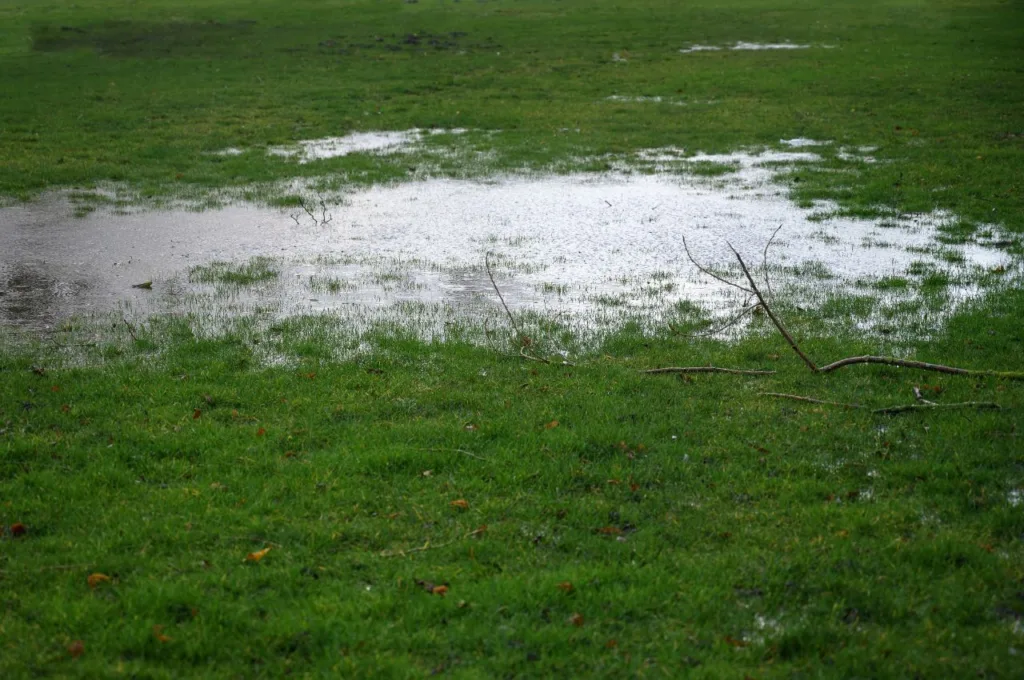
🌬 Sudden Freezing
Sudden freezing, otherwise known as crown freeze, occurs when a sudden period of freezing weather follows a spell of relatively warm, moist weather. This usually happens towards the end of the winter or early spring, when the last frost hasn’t yet passed and the weather doesn’t quite know what it’s doing.
Sudden freezing kills grass because the plant crowns absorb water when exposed to moist conditions – and this water then freezes, leading to fast expansion of the plants’ cell walls.
How To Prevent
There’s not a lot you can do to prevent winter kill from sudden freezing. Luckily, the cool-season grass species used in UK gardens are less susceptible to the effects of crown freeze anyway, so you shouldn’t have to worry too much about this possible cause of grass death.
Ensuring that your lawn is fertilized and aerated will generally help your grass to avoid severe damage as a result of the changing temperatures over winter and spring.
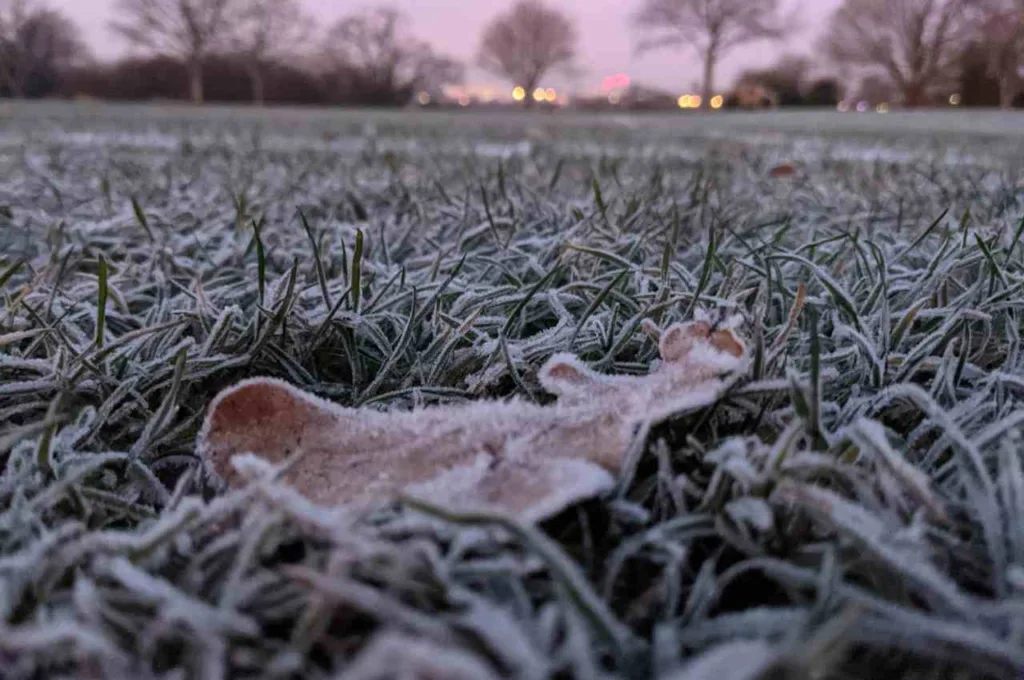
☀️ Lack Of Sunlight
A lack of sunlight is another reason why you’re likely to notice dead grass and other lawn problems in the winter.
Without sufficient sunlight, grass can’t produce the energy it needs to sustain its growth and metabolic processes. Grass roots are deprived from the nutrients they need for a healthy lawn.
In the UK, we get twice as much sunlight in the summer as we do in the winter – so it makes sense that our grass suffers the effects of a lack of sunlight in the colder months.
How To Prevent
Unfortunately, there’s nothing you can do to prevent the effects of a lack of sunlight in the winter, aside from the autumn general lawn maintenance practices that we recommend to protect your lawn from general winter conditions.
If you want to go all out, you can buy grow lights to use on your lawn over winter, but in all honesty, we don’t recommend these – they’re expensive, and their benefits aren’t worth the cost for the average UK lawn.
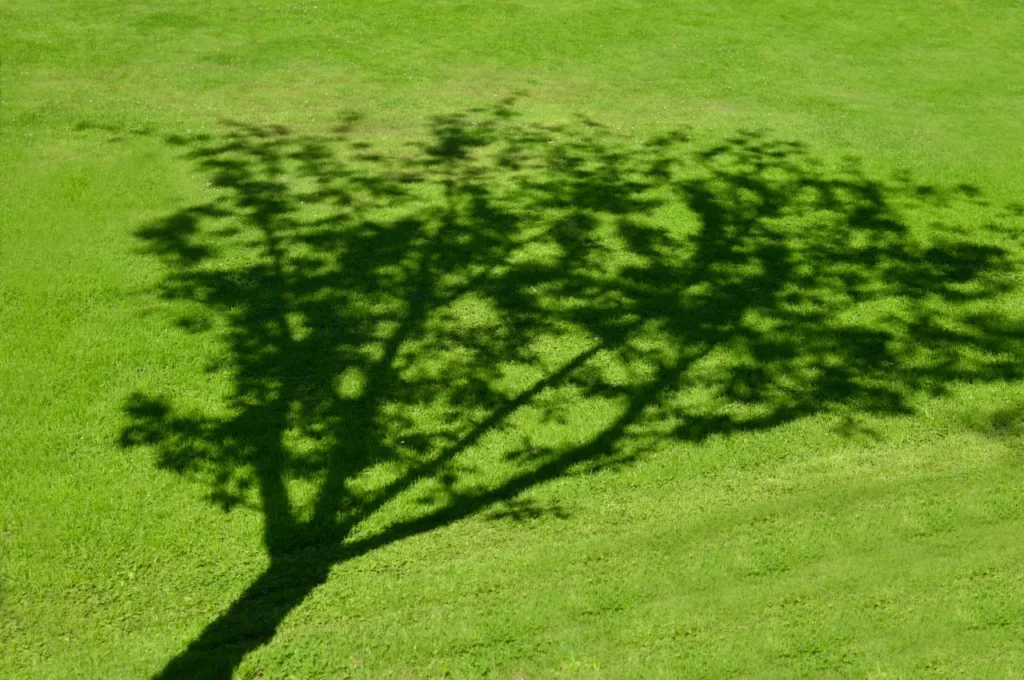
🤏 Compacted Soil
Late autumn and winter present the greatest compaction risk for soil in the UK, bringing cool temperatures and wet weather.
Compaction occurs when soil particles are pressed tightly together, reducing the pore spaces between them. This compression leads to poor drainage and restricts the movement of air, water, and nutrients within the soil – all of which spell bad news for grass growth.
Why is your lawn more at risk of compaction in winter? When soil freezes and thaws during the colder season, it can lead to soil particles being pushed together. This, in turn, increases compaction.
How To Prevent
The best way to prevent issues with soil compaction over the winter season is to aerate the soil at some point between late September and early November.
Aerating your lawn in autumn will help prevent compaction caused by winter weather conditions. By aerating before winter, you’ll open up your lawn’s root zone and provide a more favorable environment for roots to resist this problem.
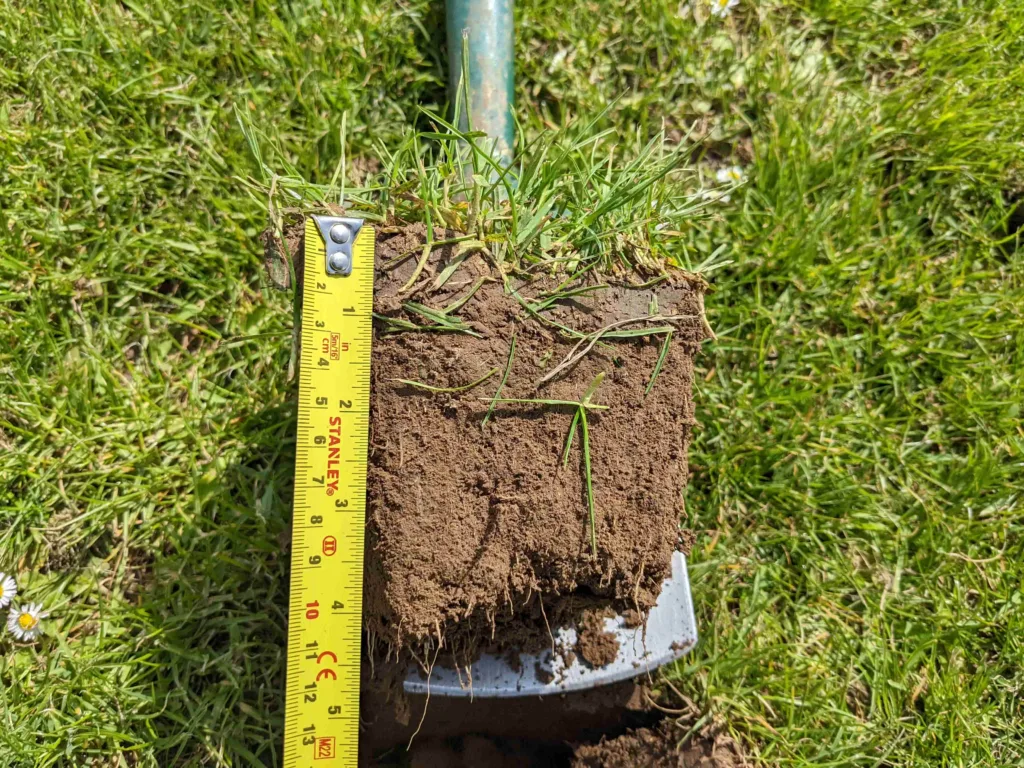
📊 Factors That Affect Grass Damage During Winter
There are a few factors that affect the likelihood of your lawn becoming damaged or dying out during the cold season:
The temperature. Winters in the UK guarantee cold temperatures, but sometimes, our winter weather is worse than usual. A sudden freeze or weeks of below-freezing temperatures increase the likelihood of damage to grass over winter.
Sunlight access. Even the shade-friendly grass species in the UK need access to sunlight to survive. Sunlight during the winter season also helps to prevent the grass from freezing, which protects it from damage caused by frost. The less sunlight that hits your lawn over the winter months, the more likely you are to notice patches of dead grass.
Your pre-winter lawn care practices. The better you can prepare your lawn for the winter, the better it’ll withstand the months of cold weather. Aerating and fertilising your lawn, reducing thatch to lower disease risk, and weeding to reduce competition for nutrients, will all help your grass survive over the cold season.
🤨 What To Do About Dead Grass After Winter
So, winter is over – but your grass is still showing signs of damage from the colder season. Parts of your lawn appear to have died. What next?
The only feasible solution to grass that has died over winter is to rake away the dead patches and start again.
Grass won’t grow back once it’s dead, so there’s no point waiting around for the dead patches to green up. Instead, once spring comes around, use a rake to scrape away the brown grass, or cut away the area with a shovel.
Next, overseed the bare patches with a quality grass seed – we recommend the Pronto Seed Grass Seed (< Amazon link) for UK lawns, or read our complete guide to the best grass seed in the UK for the full list of different seed products for different circumstances. With proper aftercare, the grass should begin to grow within 2-3 weeks of sowing.
FAQ
How do you stop grass dying in the winter?
The best way to stop grass dying in the winter is to implement a number of preventative winter lawn care practices in autumn, including applying a lawn feed, aerating the lawn, spot-treating weeds, and raking out thatch.
Why does my lawn turn to mud in winter?
Your lawn might turn to mud in the winter due to a buildup of thatch and moss, waterlogging in compacted areas, and a lack of access to sunlight. Your lawn should recover by early spring, but if you want to prevent the winter mudbath, make sure to aerate the soil in autumn – and consider installing a drainage system if necessary.
What does frost damage look like on grass?
Frost damage on grass plants looks like brown or yellow discoloration on the leaves, especially on the leaf tips. This is caused by the frozen water inside the grass cells, causing tissue damage that makes the ends of the leaves turn brown.
Will dead grass come back?
No, once grass has died, it won’t come back. If your lawn is patchy, with areas of dead grass, your only solution is to rake away the dead grass and sow new seed in the bare areas.
